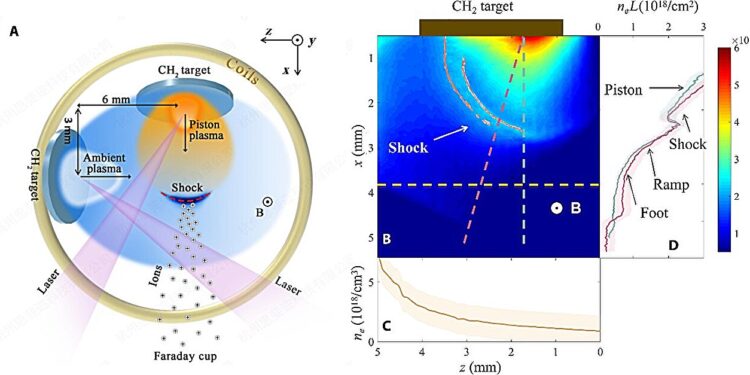Shock experiences without laser magnetized collision. Credit: Hui-Bo Tang et al.
Researchers from the University of Sciences and Technology of China (USTC) carried out the first direct observation of the laboratory of the acceleration of ions by reflecting shocks without magnetized collision generated in the laser. This observation shows how the ions gain energy by bouncing on supercritical shocks, at the heart of the Fermi acceleration mechanism. Research is published in Scientific advances.
Shocks without collision are cosmic powers responsible for the acceleration of particles responsible for extreme energies. This acceleration involves particles crossing the shock fronts several times, gradually gaining energy. However, how do particles initially earn enough energy to enter this cycle? Two competing theories, the acceleration of the shock drift (SDA) and the acceleration of shock surfing (SSA), have emerged, but the limits of observation of space and previous laboratory experiences have left the unresolved question.
This new experience, conducted at the Chinese installation of the Shenguang-II laser, has recreated a controlled astrophysical shock scenario. The researchers used high energy lasers to generate a magnetized ambient plasma and a “piston” supersonic plasma. When the piston collided with the plasma ambient at speeds exceeding 400 km / s, it produced an almost supercritical impact, similar to those observed near the earth.
Advanced diagnostics, including optical interferometry and the flight time measures, have captured the structure of the shock and the dynamics of the ions. The team observed a beam of almost monoenergetic ions upstream upstream at 1,100–1,800 km / s, two to four times the shock speed. This fast ion component reflected the signatures detected in shock from the earth arc but with unprecedented clarity.
Ionic speed spectra in 1D PIC experiments and simulations. Credit: Hui-Bo Tang et al.
The key to discovery was the simulations of cell particles, which followed the ionic trajectories and the electromagnetic fields. The simulations have revealed that the reflected ions gained energy mainly through the electric shock -movement field – a characteristic of the SDA. During the reflection, the ions interacted with the electrostatic field of the shock and the compressed magnetic field, accelerating the long and perpendicular to the shock front. This double acceleration mechanism produced a distinct high -speed ion beam.
In particular, the force of the magnetic field of experience (5–6 Tesla) and plasma conditions have filled the gap between previous laboratory studies and astrophysical shocks, allowing a direct comparison with spatial observations. Above all, the results excluded the SSA as the dominant process, regulating an old debate for several decades.
By confirming the role of SDA in the injection of ions, the study validates the models used to interpret the origins of cosmic rays and the remains of supernova. In addition, the design of the experience – a reproducible and granted shock platform – offers a new tool to study the dynamics of high energy particles under controlled conditions. Potential applications include the optimization of laser laser ion accelerators, where magnetic fields could improve the quality of the beam and improve inertial containment fusion by attenuating the instabilities induced by shocks.
This breakthrough not only increases our understanding of the universal acceleration of particles, but also shows how laboratory experiences can complete spatial exploration. While researchers refine these methods, future studies can disentangle how repeated reflections create the extreme energies observed in cosmic rays, bringing humanity closer to the decoding of the most powerful accelerators in the universe.
More information:
Hui-Bo Tang et al, observation in the laboratory of acceleration of the drift of ions via the reflection of shocks without magnetized collision produced in laser, Scientific advances (2025). DOI: 10.1126 / SCIADV.ADN3320
Supplied by the University of Science and Technology of China
Quote: Direct observation in the laboratory reveals a key mechanism behind the acceleration of cosmic particles (2025, April 23) recovered on April 23, 2025 from
This document is subject to copyright. In addition to any fair program for private or research purposes, no part can be reproduced without written authorization. The content is provided only for information purposes.


